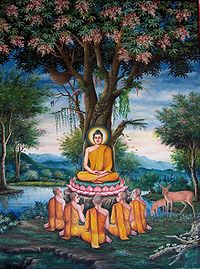- Original Teachings of the Buddha
-
Original Teachings of the Buddha refer to the teachings of the historical Siddhartha Gautama, also known as the Buddha. What the original teachings were, or Buddha Vacana ("word of the Buddha") has been the subject of debate and historical argument for centuries. These source teachings have given rise to the numerous schools and traditions of Buddhism that exist today.
In modern academia, the sutta pitakas of the Pali Canon, and Chinese Agamas as well as surviving fragments of the Sanskrit Canon and Gandhari Canon have been identified as containing the earliest known record of these teachings. However, the teachings passed down over a period of many centuries as an oral tradition before being committed to writing. During this time they were codified in a form suitable for easy memorization and chanting. Academics are in disagreement over the content of the original source teachings that gave rise to these various recensions and the numerous traditions and scriptures that arose later based on these.
Dhamma-Vinaya
Across various early sources, the Buddha is recorded as referring to his teaching as the Dhamma and Vinaya (discipline).[1] Although the Pali Canon is traditionally divided into the 'three baskets' of the Vinaya, Sutta's and Abhidhamma, the Buddha of the early recensions makes no mention of an Abhidhamma indicating that this basket of teachings was a later addition and not originally part of the Buddha's teachings.
In one sutta of the Pali Canon, the Buddha is seen giving instruction on how to recognize what is the genuine teaching and what is not:
Gotami, the qualities of which you may know, 'These qualities lead to passion, not to dispassion; to being fettered, not to being unfettered; to accumulating, not to shedding; to self-aggrandizement, not to modesty; to discontent, not to contentment; to entanglement, not to seclusion; to laziness, not to aroused persistence; to being burdensome, not to being unburdensome': You may definitely hold, 'This is not the Dhamma, this is not the Vinaya, this is not the Teacher's instruction. As for the qualities of which you may know, 'These qualities lead to dispassion, not to passion; to being unfettered, not to being fettered; to shedding, not to accumulating; to modesty, not to self-aggrandizement; to contentment, not to discontent; to seclusion, not to entanglement; to aroused persistence, not to laziness; to being unburdensome, not to being burdensome': You may definitely hold, 'This is the Dhamma, this is the Vinaya, this is the Teacher's instruction.[2]— Gotami suttaReferences
- ^ "Esukari Sutta". http://books.google.co.uk/books?id=g5YfHBF10aoC&pg=RA2-PA789&lpg=RA2-PA789&dq=dhamma+and+discipline+tathagata&source=bl&ots=HECih5APG8&sig=32u4_nMASneMC4Ev7jIeKCVGHXg&hl=en&ei=d5aKSr74Jt22jAfo1IRb&sa=X&oi=book_result&ct=result&resnum=7#v=onepage&q=&f=false.
- ^ "Gotami sutta". http://www.accesstoinsight.org/tipitaka/an/an08/an08.053.than.html.
Categories:- History of Buddhism
- Buddhist biography stubs
Wikimedia Foundation. 2010.

